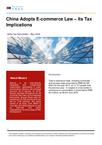May 2019 - China Adopts E-commerce Law – Its Tax Implications
Background
The success of online marketing is shown by the results of Alibaba’s November 11 “Singles Day” online sales event. The Singles Day shopping bonanza for 2017 involved more than 140,000 participating merchants, including 60,000 international brands, as reported by ZD Net. 165 of these merchants generated more than RMB 100 million in sales for each, including GAP, NIKE and Samsung, with 17 merchants exceeding RMB 500 million and 6 surpassing RMB 1 billion in sales.
Towards this increasingly flourishing e-commerce market, China adopts an e-commerce law aimed at improving regulation of the market. The E-commerce Law (“the Law”) is effective on 1 January, 2019. The Law clarifies e-commerce operators into e-commerce platform operators such as Taobao (淘宝), merchants on e-commerce platforms, e.g., Walmart having its own e-commerce platform, as well as those doing business on their own websites or via other web services, such as individuals who might be selling goods via social networks such as the popular chatting app WeChat. For example, in a recent case, an airline stewardess was fined and sentenced to jail because she brought goods from overseas and sold the goods through her social on-line networks.
This tax newsletter discusses the tax and Customs implications to the Chinese customers and the Chinese tax implications to the merchants who carries out cross border e-commerce activities. The merchants can then decide which model suits them better in attracting the Chinese customers with the least tax costs.
Overseas Purchase Channels
Chinese consumers can gain access to foreign goods via four channels:
- Ordering directly from overseas e-commerce sites (e.g., Amazon, macys.com, rakuten.com, etc). This type of online shopper seeks qualify and authentic products. These overseas purchase activities are usually referred as “haitao” (海淘).
- Ordering through purchasing agents, who provide assistance on payment and delivery to their Chinese consumers. This type of online shopping is usually referred to as “daigou” (代购), and
- Cross-border e-commerce, which usually refers to overseas brands merchants selling directly to Chinese consumers through domestic cross-border e-commerce platforms (e.g., Taobao, Tmall and Tmall Global (天猫国际), JD Wordwide (京东全球购), XiaoHongShu (小红书), Yihaodian (1号店) etc) and cross-border e-commerce platforms in pilot cities[1] (eg., Shanghai, Zhengzhou, Chongqing, Hangzhou and Ningbo, etc ).
- Normal Trade
Chinese customers would purchase their products from Chinese entities which would in turn import the goods through internet.
According to China Internet Watch, 60% of online shoppers buy cross-border products through domestic e-commerce channels, while 40% use overseas global e-commerce websites. Chinese online buyers’ mainly make non-domestic purchases from the US, followed by Hong Kong, Malaysia, the Netherlands and South Korea. The most sought-after imported product categories are cosmetics and personal care products, food and beverages, baby products, and apparel and accessories.
Taxation and Customs Duty With Respect to Chinese Consumers:
The Chinese government released a circular, Cai Guan Shui (2016) No. 18 to specifically clarify import tax policies for goods imported under the cross-border e-commerce model. The circular, which came into force on 8 April, 2016, stipulates that consumers purchasing goods imported under both the direct shipping model and the bonded warehouse model need to pay import taxes including tariffs, import VAT and consumption tax, if applicable. Following the tax rates adjustment, the Chinese government issued the Cross Border e-Commerce Imported Goods List to clarify what types of goods are allowed to be imported under a cross-border e-commerce model.
The import taxes are covered by either the so-called “Parcel Tax” (or “Postal Tax”) for the first two channels or Composite Tax for qualified cross-border e-commerce. These are discussed below:
- Parcel or Postal Tax
The Parcel or Postal Tax only applies to goods brought into China for personal use by Chinese residents. Effective 1 November, 2018, the levels of tax brackets have been set at 15%, 25% or 50%. The Parcel or Postal Tax will be exempted if the tax is less than RMB 50.
In this arrangement, the individual would buy the goods directly from e-commerce platforms such as Amazon US. When the goods are imported, the Customs would levy the Parcel or Postal Tax, and the individual would be informed to pay the tax directly to the Customs before he can receive the goods. In practice, the Customs would perform random check to select the goods either delivered by courier or postal.
The value for computing the tax is based on the retail price plus transportation and insurance fees being charged by the e-commerce service provider.
In respect of returning goods, the practice of obtaining refund of the Parcel and Postal Tax varies between locations. In general, the tax could be refunded.
- Composite Tax for Qualified Cross-border E-commerce
There are actually two models under this category. The goods are purchased through domestic e-commerce platforms which may be connected with overseas e-commerce platforms or connected directly with the merchants.
For goods imported under Qualified Cross-border E-commerce, the goods imported and delivered to the individual customer would be subject to Customs Duty (“CD”), Consumption Tax (“CT”) and Import Value-added Tax (“VAT”). The e-commerce service provider must register with the Customs and relevant authorities to exchange transaction data. These are domestic e-commerce service providers such as Tmall Global, JD Worldwide etc.
The Chinese cross-border e-commerce platform operators are connected with the Chinese Customs and have Customs declaration, payment and logistic information registered with the Customs for their verification. Alternatively, if the goods are delivered directly to the customers without the platform operators connected with the Chinese Customs, the logistic companies delivering the good would provide the payment, logistic and order information to the Customs and collect the relevant VAT and Customs Duty from the customer.
Effective 1 January 2019, in an attempt to encourage individuals purchasing non-Chinese goods through domestic e-commerce platforms, if the purchase is within the thresholds applicable to each individual purchaser, the purchase would be exempted from CD, and there is a 30% reduction of the applicable CT and VAT. The thresholds are less than RMB 5,000 for each individual purchase and a cumulative annual purchase of RMB 26,000. The e-commerce service providers, or the logistic companies as the case maybe, will act as withholding agent and pay tax on behalf of individual customers. Unlike the Parcel and Postal Tax, there is no tax exemption. The value for computing the Composite Tax will be the retail price plus the shipping and insurance costs.
In respect of returning of goods, the individual customer needs to apply for the tax refund to the Customs within 30 days from the day the Customs release the goods.
- Normal Trade ( B2B)
Under the normal B2B arrangement, full CD, CT and VAT will be applicable, unless there is an applicable preferential rate available under any Free Trade Agreement. The normal Customs declaration procedures would be applicable.
The tax implication to the overseas vendor
For the overseas vendor, the tax implication is whether the profit on selling the goods would be subject to Enterprise Income Tax in China and if the profit is subject to Enterprise Income Tax in China, whether the vendor can claim a foreign tax credit for the jurisdiction in which the vendor operates.
Forming a domestic company to sell the goods
Under this scenario, the overseas merchant would form a Chinese subsidiary who will be importing the goods from overseas and then selling the imported goods through domestic e-platform operators. The Chinese subsidiary would be subject to Import Duty on importing the goods, VAT on selling to the individual consumers, and Enterprise Income Tax on the trading profits. It may pay a fee to the e-platform operator for the e-commerce service. Such fee would be subject to VAT. Since the Chinese subsidiary is purchasing the goods from its related overseas merchant, there would be transfer pricing to be taken care of.
For the individual consumer, as the end user, he would purchase the goods at a price which includes the applicable VAT.
The E-Commerce Law
The Law became effective from 1 January 2019. E-commerce is defined to include all business activities of commodities sales or provision of services through information technology networks such as the internet. The Law regulates different players in e-commerce, including the e-commerce platform operators such as Tao Bao, vendors operating on platforms, and sellers through other electronic portals. The objectives of the Law are to regulate unfair competition, strengthen IP protection, shared liability for platforms and emphasizing on consumer’s privacy and rights. The Law has impacts on taxation, including requirements to comply with tax regulations to register as taxpayers and to fulfil tax obligations, and with respect to cross-border e-commerce players, complying with import-export Customs rules. All e-commerce players must issue paper invoices, electronic invoices or other service documentary evidence to consumers to substantiate the transactions. Platform operators must check the business registration and tax registration information of Operators on Platforms, i.e., online vendors and provide such information to the tax authorities.
In summary, the Law’s main focus is on regulating e-commerce but it also ensures the e-commerce operators comply with the tax laws.
Implications to Companies Desiring to Engage in E-commerce Retail Business in China
With the introduction of the Law, e-retailers, e-commerce merchants, including Daigou, must register with the State Administration for Industry and Commerce to obtain a business license. For platform operators, they must examine the qualification of the vendors and must respond in a timely manner to reports of violations or face hefty penalties. In addition, the compliance in taxation is reinforced.
Overseas companies who wish to engage in e-commerce retail business in China should evaluate the feasibility and tax implications of different operational models, such as domestic model by forming a Chinese subsidiary, vs cross-border e-commerce as discussed above, and the inventory model ( such as direct mail or storage in bonded warehouses ). If a Chinese company were to be formed, that company would be subject to the regulatory administration of the new E-commerce Law and the Chinese taxation, including transfer pricing.
Each of the e-commerce models has its pros and cons. Mazars would be able to assist in analyzing which model suits the operation of the overseas merchants.
Download our latest tax newsletter to explore more details and read Mazars' suggestions.
Forbidden
Something is broken. Please let us know what you were doing when this error occurred. We will fix it as soon as possible. Sorry for any inconvenience caused.
This website uses cookies.
Some of these cookies are necessary, while others help us analyse our traffic, serve advertising and deliver customised experiences for you.
For more information on the cookies we use, please refer to our Privacy Policy.
-
This website cannot function properly without these cookies.
-
Analytical cookies help us enhance our website by collecting information on its usage.


